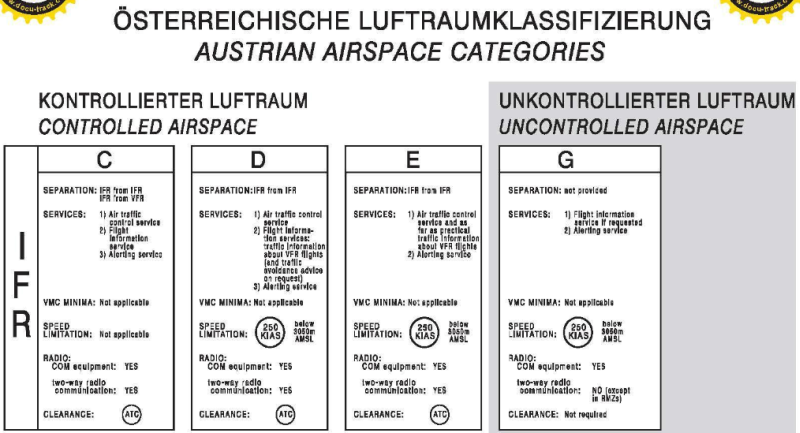Difference between revisions of "Airspace classes"
Jump to navigation
Jump to search
David Leitl (talk | contribs) |
m (→Airspace D) |
||
| Line 28: | Line 28: | ||
* Alert service is provided | * Alert service is provided | ||
* Pilots must request permission and receive clearance before entry | * Pilots must request permission and receive clearance before entry | ||
| − | * '''All Aircraft fly 250kts or less''' (so that VFR can see-and-avoid). | + | * '''All Aircraft fly 250kts or less (below 10.000ft)''' (so that VFR can see-and-avoid). |
= Airspace E= | = Airspace E= | ||
Latest revision as of 17:33, 20 December 2021
Airspace classes are types of airspace which tell pilots...
- If they are allowed to enter it and under which circumstances (depending on visibility, aircraft type and flight rule)
- If they need to file a flight plan before entry, request clearance, report, or just do nothing
These classes are limited laterally (they have borders to neighbouring airspaces) and vertically (they are sliced in flight levels).
ICAO airspaces have letters ranging from A thru G.
Austrian Airspace uses the following classifications ((c) Austrocontrol):
Airspace C
... is the highest used in Austria (We don't use B and A - it's only used in extremely busy terminal areas where VFR flights are completely banned). C means...
- ATC service is provided ( = a controller is there who gives orders) to separate IFR from IFR and IFR from VFR (No separation VFR/VFR!)
- FIS service is provided (Flight Information Service = a controller who gives information)
- Alert service is provided in case airplanes get too close to each other.
- Two-way radio contact is mandatory.
- Pilots need to request permission and clearance by ATC.
Airspace D
... is one step less rigid:
- ATC service is provided, separating IFR from IFR (not IFR/VFR, and not VFR/VFR: They should see-and-avoid).
- FIS is provided (Flight Information Service)
- Alert service is provided
- Pilots must request permission and receive clearance before entry
- All Aircraft fly 250kts or less (below 10.000ft) (so that VFR can see-and-avoid).
Airspace E
... is one more step less rigid:
- ATC service is provided, separating IFR from IFR (not IFR/VFR, and not VFR/VFR: They should see-and-avoid).
- FIS is provided (Flight Information Service) only when practical
- Alert service is provided
- only IFR-Pilots must request permission and receive clearance before entry
- All Aircraft fly 250kts or less (so that VFR can see-and-avoid).
Airspace G
... is uncontrolled airspace:
- No ATC service is provided
- FIS service is provided
- Alert service is provided
- All Aircraft fly 250kts or less below 10.000ft).
- Pilots can enter at their discretion.
- Pilots must have at least one-way communication (a receiver). Consequently, they may report in, but don't need to.
